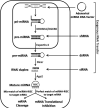In vivo, cardiac-specific knockdown of a target protein, malic enzyme-1, in rat via adenoviral delivery of DNA for non-native miRNA
- PMID: 22974418
- PMCID: PMC3651674
- DOI: 10.2174/156652312803519760
In vivo, cardiac-specific knockdown of a target protein, malic enzyme-1, in rat via adenoviral delivery of DNA for non-native miRNA
Abstract
This study examines the feasibility of using the adenoviral delivery of DNA for a non-native microRNA to suppress expression of a target protein (cytosolic NADP(+)-dependent malic-enzyme 1, ME1) in whole heart in vivo, via an isolated-heart coronary perfusion approach. Complementary DNA constructs for ME1 microRNA were inserted into adenoviral vectors. Viral gene transfer to neonatal rat cardiomyocytes yielded 65% suppression of ME1 protein. This viral package was delivered to rat hearts in vivo (Adv.miR_ME1, 10(13) vp/ml PBS) via coronary perfusion, using a cardiac-specific isolation technique. ME1 mRNA was reduced by 73% at 2-6 days post-surgery in heart receiving the Adv.miR_ME1. Importantly, ME1 protein was reduced by 66% (p < 0.0002) at 5-6 days relative to sham-operated control hearts. Non-target protein expression for GAPDH, calsequestrin, and mitochondrial malic enzyme, ME3, were all unchanged. The non-target isoform, ME2, was unchanged at 2-5 days and reduced at day 6. This new approach demonstrates for the first time significant and acute silencing of target RNA translation and protein content in whole heart, in vivo, via non-native microRNA expression.
Figures






Similar articles
-
Enhanced Redox State and Efficiency of Glucose Oxidation With miR Based Suppression of Maladaptive NADPH-Dependent Malic Enzyme 1 Expression in Hypertrophied Hearts.Circ Res. 2018 Mar 16;122(6):836-845. doi: 10.1161/CIRCRESAHA.118.312660. Epub 2018 Jan 31. Circ Res. 2018. PMID: 29386187 Free PMC article.
-
Mitochondrial malic enzyme 3 is important for insulin secretion in pancreatic β-cells.Mol Endocrinol. 2015 Mar;29(3):396-410. doi: 10.1210/me.2014-1249. Epub 2015 Jan 16. Mol Endocrinol. 2015. PMID: 25594249 Free PMC article.
-
Chronic reduction of the cytosolic or mitochondrial NAD(P)-malic enzyme does not affect insulin secretion in a rat insulinoma cell line.J Biol Chem. 2009 Dec 18;284(51):35359-67. doi: 10.1074/jbc.M109.040394. J Biol Chem. 2009. PMID: 19858194 Free PMC article.
-
Malic enzyme 1 (ME1) in the biology of cancer: it is not just intermediary metabolism.J Mol Endocrinol. 2020 Nov;65(4):R77-R90. doi: 10.1530/JME-20-0176. J Mol Endocrinol. 2020. PMID: 33064660 Free PMC article. Review.
-
Significance of Malic Enzyme 1 in Cancer: A Review.Curr Issues Mol Biol. 2025 Jan 29;47(2):83. doi: 10.3390/cimb47020083. Curr Issues Mol Biol. 2025. PMID: 39996805 Free PMC article. Review.
Cited by
-
Combined adenovirus-mediated artificial microRNAs targeting mfgl2, mFas, and mTNFR1 protect against fulminant hepatic failure in mice.PLoS One. 2013 Nov 26;8(11):e82330. doi: 10.1371/journal.pone.0082330. eCollection 2013. PLoS One. 2013. PMID: 24303082 Free PMC article.
-
Enhanced Redox State and Efficiency of Glucose Oxidation With miR Based Suppression of Maladaptive NADPH-Dependent Malic Enzyme 1 Expression in Hypertrophied Hearts.Circ Res. 2018 Mar 16;122(6):836-845. doi: 10.1161/CIRCRESAHA.118.312660. Epub 2018 Jan 31. Circ Res. 2018. PMID: 29386187 Free PMC article.
-
Mitochondrial pyruvate carriers are required for myocardial stress adaptation.Nat Metab. 2020 Nov;2(11):1248-1264. doi: 10.1038/s42255-020-00288-1. Epub 2020 Oct 26. Nat Metab. 2020. PMID: 33106689 Free PMC article.
-
MicroRNAs in T Cell-Immunotherapy.Int J Mol Sci. 2022 Dec 23;24(1):250. doi: 10.3390/ijms24010250. Int J Mol Sci. 2022. PMID: 36613706 Free PMC article. Review.
-
Assessing Cardiac Metabolism: A Scientific Statement From the American Heart Association.Circ Res. 2016 May 13;118(10):1659-701. doi: 10.1161/RES.0000000000000097. Epub 2016 Mar 24. Circ Res. 2016. PMID: 27012580 Free PMC article. Review.
References
-
- Gray SJ, Samulski RJ. Optimizing gene delivery vectors for the treatment of heart disease. Expert Opin Biol Ther. 2008;8(7):911–22. - PubMed
-
- Muller OJ, Katus HA, Bekeredjian R. Targeting the heart with gene therapy-optimized gene delivery methods. Cardiovasc Res. 2007;73(3):453–62. - PubMed
-
- Poller W, Fechner H. Development of novel cardiovascular therapeutics from small regulatory RNA molecules—an outline of key requirements. Curr Pharm Des. 2010;16(20):2252–68. - PubMed
Publication types
MeSH terms
Substances
Grants and funding
LinkOut - more resources
Full Text Sources
Research Materials
Miscellaneous

